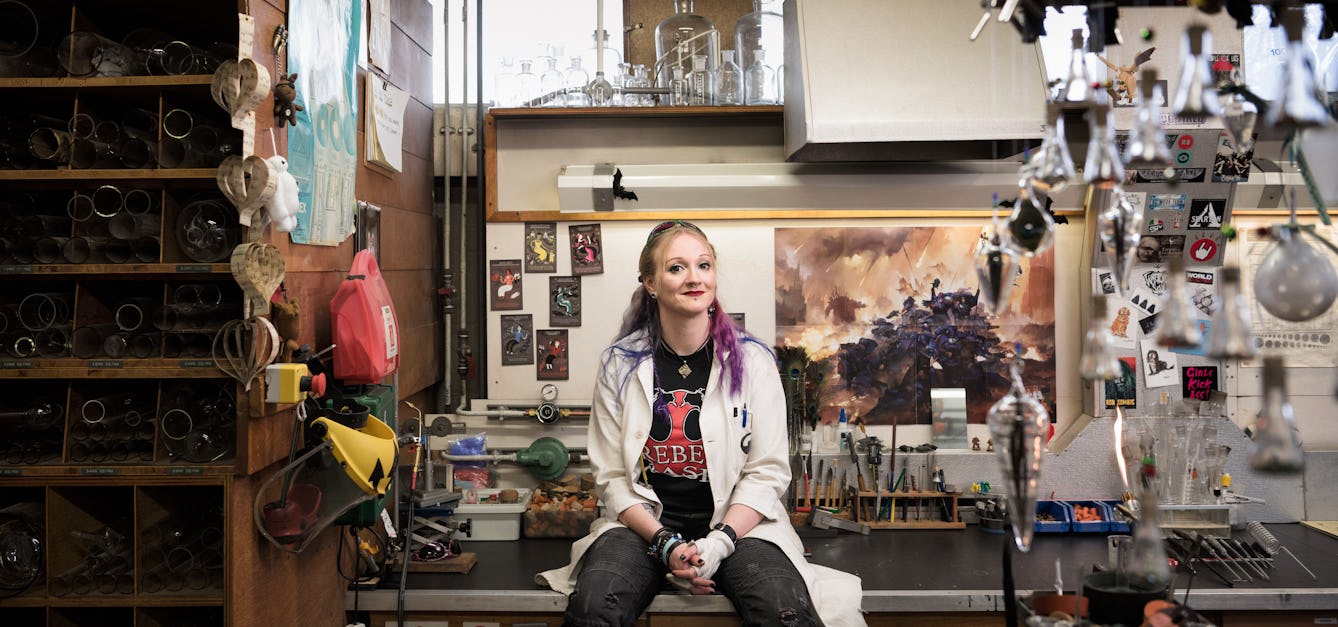Stories

- Article
The secret lives of Britain’s first Black physicians
Dr Annabel Sowemimo explores the web of connections between early Black British doctors, the role of empire in West Africa and the pernicious reach of scientific racism.

- Photo story
Obesity and Britain’s boys
Six young men and six experiences of being overweight. Find out how these boys and their loved ones feel about this stigmatising issue.

- Article
The hell of hay fever
After years suffering in silence, David Jesudason finds speaking out about his pollen allergy gives him hope for a future where his hay-fever symptoms are under control.

- Article
The art of scientific glassblowing
Exciting things happen when art, craft, engineering and science collide. Glassblower Gayle Price is proof of that.
Catalogue
- Archives and manuscripts
Visitors' Book: Wellcome Clinical Investigation Unit, The Department of Medicine, King's College School of Medicine and Dentistry
Date: 1990Reference: WF/WRL/06/04Part of: Wellcome Foundation Ltd- Books
Oxford case histories in sleep medicine / Himender Makker, Consultant Physician in Respiratory Medicine, North Middlesex University and University College London (UCL) Hospital, London, UK, Matthew Walker, Profesor of Neurology, UCL Institute of Neurology, Queen Square, London, UK, Hugh Selsick, Psychiatrist, Camden and Islington NHS Trust London, and the Royal London Hospital for Integrated Medicine, London, UK, Bhik Kotecha, Consultant ENT Surgeon and Lead Clinician for Snoring and Sleep Service, The Royal National Throat Nose and Ear Hospital, UCL, London, and Barking, Havering, and Redbridge University Hospital, London, UK, Ama Johal, Senior Clinical Lecturer/Hon. Consultant Orthodontist, Academic and Clinical Lead Orthodontics Institute of Dentistry Bart's, and The London School of Medicine and Dentistry, Queen Mary College, London, UK.
Makker, HimenderDate: 2015- Books
ABC of domestic and sexual violence / edited by Susan Bewley, Women's Health Academic Centre, King's College London, UK, Jan Welch, Caldecot Centre, King's College Hospital NHS Foundation Trust, UK and South Thames Foundation School, UK.
Date: 2014- Archives and manuscripts
King's College London Department of Biophysics
King's College London, Department of BiophysicsDate: 1945-1992Reference: KDBP- Archives and manuscripts
Papers of M H F Wilkins: papers relating to the department of Human Nutrition, London School of Hygiene and Tropical Medicine
Date: 1982-1983Reference: K/PP178/11/8/11Part of: Wilkins, Maurice Hugh Frederick (1916-2004)

![Agrimonia eupatoria L. Agrimony, Eupatorium, Maudlein. Perennial herb. The species name comes from king Mithridates Eupator VI of Pontus (132-63 BC) who took regular doses of poison to develop an immunity to them. A 'Mithridate' was a medicine against poisons. Distribution: N. and S. Africa, N. Asia, Europe. '…provokes urine and the terms [periods], dries the brain, opens stoppings, helps the green sickness [iron deficiency anaemia], and profits such as have a cold weak liver outwardly applied it takes away the hardness of the matrix [=uterus] and fills hollow ulcers with flesh' (Culpeper, 1650). Dioscorides (Beck, 2005) recommends mashed leaves in hog's grease for healing scarring ulcers, and the seed in wine for dysentery and serpent bites. Goodyear's 1655 translation of Dioscorides (Gunther 2000) has this as cannabis, which Parkinson (1640) says is in error and summarises the manifold uses from classical authors, from removing splinters to stopping menorrhagia. Photographed in the Medicinal Garden of the Royal College of Physicians, London.](https://iiif.wellcomecollection.org/image/B0008921/full/282%2C/0/default.jpg)




![Salvia coahuilensis Fernald Lamiaceae Coahuila Sage. Perennial shrub. Distribution: Mexico. Most of the historical medicinal literature is on common sage, Salvia officinalis. The name Salvia meaning 'healthy'. Elizabeth Blackwell (1737) wrote that it had "... all the noble Properties of the other hot Plants more especially for the Head, Memory, Eyes, and all Paralytical Affections. In short, 'tis a Plant endu'd with so many and wonderful Properties, as that the assiduous use of it is said to render Men Immortal" with which Hans Sloane agreed. Its health giving properties were recorded in the aphorisms of the School of Salerno (fl 9-13th century) - quoted in the Decameron [c.1350, translated: Why should man die when Salvia grows in the Garden']. Some salvias, such as Salvia divinorum contain hallucinogenic compounds. Photographed in the Medicinal Garden of the Royal College of Physicians, London.](https://iiif.wellcomecollection.org/image/B0009179/full/282%2C/0/default.jpg)
![Salvia nemorosa L. Lamiaceae Woodland sage. Balkan clary Distribution: Central Europe, Western Asia. Most of the historical medicinal literature is on common sage, Salvia officinalis. The name Salvia meaning 'healthy'. Elizabeth Blackwell (1737) wrote that it had "... all the noble Properties of the other hot Plants more especially for the Head, Memory, Eyes, and all Paralytical Affections. In short, 'tis a Plant endu'd with so many and wonderful Properties, as that the assiduous use of it is said to render Men Immortal" with which Hans Sloane agreed. Linnaeus (1782) also: 'Timor, Languor, Leucorrhoea, Senectus [fear, tiredness, white vaginal discharge, old age]'. Its health giving and immortality conferring properties were recorded in the aphorisms of the School of Salerno (fl 9-13th century) - quoted in the Decameron [c.1350, translated: Why should man die when Salvia grows in the Garden']. Some salvias, such as Salvia divinorum contain hallucinogenic compounds. Photographed in the Medicinal Garden of the Royal College of Physicians, London.](https://iiif.wellcomecollection.org/image/B0009180/full/282%2C/0/default.jpg)

